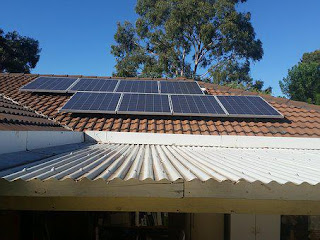How to install the solar panels at home
Installing Panels on a perfect Roof
For your solar panels to determine the correct spacing for the stanchions. Use a measuring tape and marking chalk to identify the position of each stanchion.
- It’s vital that each stanchion is located directly above a roof rafter—rafters are the wood "ribs" that provide the shape and structural support for the roof.
- With some experience, you can locate roof rafters beneath the shingles, flashing, and sheathing by tapping a hammer and listening for the difference in sound. Otherwise, you can measure from protruding objects like chimneys or exhaust pipes, or drive several pilot nails through the roof and use their location to guide your measurements.
- No part of this job is suitable for a novice. If you’re not fully confident about working on a roof and installing the solar panels correctly, hire a professional installer!.
Attach the stanchions grilling them into the roof rafters
Mark the locations for your pilot holes, then drill through the roof and into the rafters. Use the screws that come with the solar panel kit to secure the stanchions in place.
- Before securing them with screws, slide each stanchion under the edge of the row of shingles above it. That way, water will shed over top of the stanchions instead of getting underneath them.
- Many solar panel models use 3 parallel rows of aluminum rails to serve as the framework for the panels. Follow your model’s instructions for attaching these rails to the stanchions. This often involves using an impact driver to secure the rails with stainless steel bolts.
- After installing the rails and before installing the panels, check that the framework is "square" (even on all sides). Measure diagonally from corner to corner, both ways—if the measurements aren’t the same, you’ll need to adjust the framework.
This is a job best left to a professional electrician unless you are very experienced with electrical work. The tubular conduit, made of plastic or metal, protects the electrical wiring inside it from the elements.
- This wiring will need to run to both a new electric meter (to track the electricity you draw from or produce for the electrical grid) and a new electrical sub-panel. Depending on where you live, a government building code enforcement officer may be required to inspect and approve the work.
Each panel in your solar array should have its own micro-inverter. This essentially creates a parallel rather than series circuit, meaning the whole system won’t break down if one panel stops functioning. Follow your solar setup's instructions (or hire an electrician) to hook up an inverter to the framework beneath where each solar panel will go.1
- Make sure that, along with the electrical wiring, each micro-inverter is connected to a 6-gauge, bare copper ground wire. Without proper grounding, the panels will be a fire hazard if struck by lightning.
- Once the final wiring connections are made, your solar panels will be ready to start producing electricity!
https://www.partsxp.com/solaredge



Comments
Post a Comment